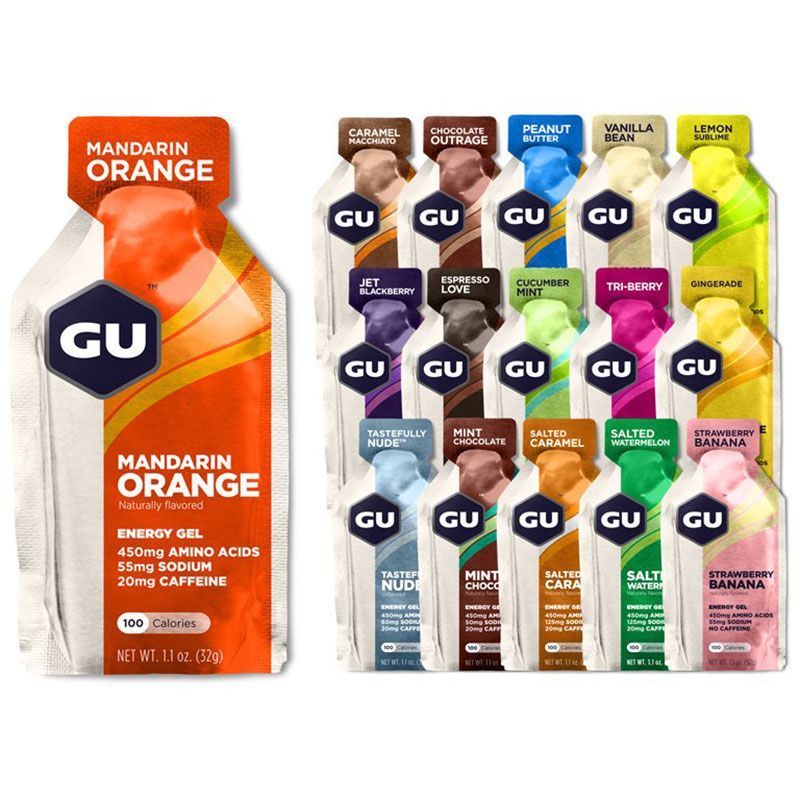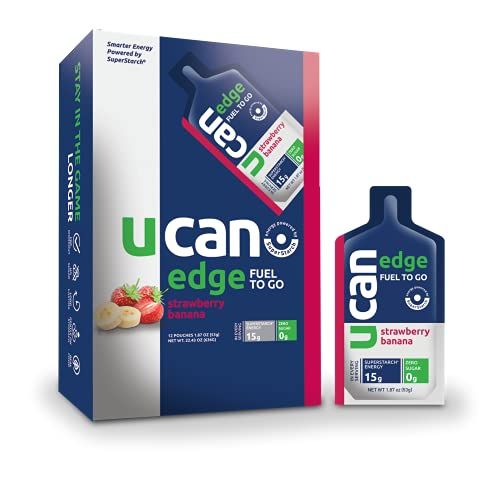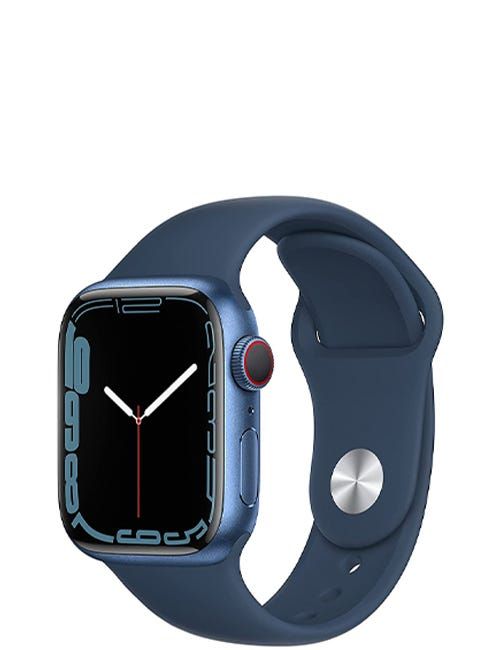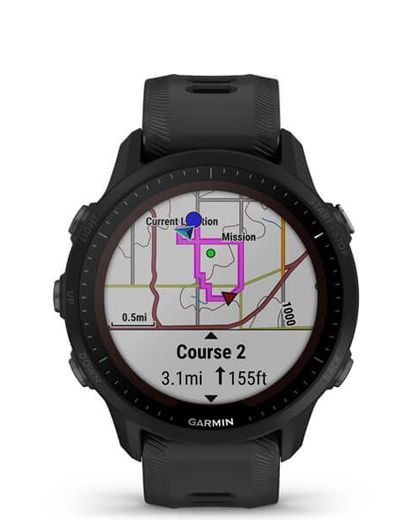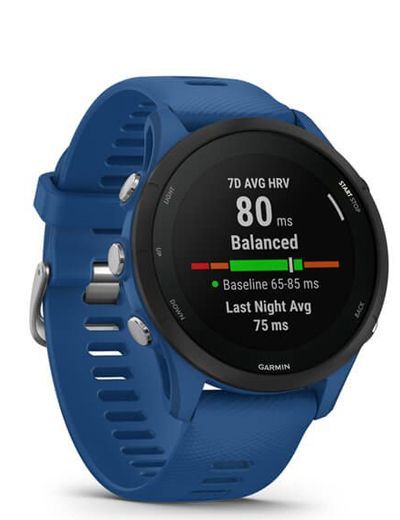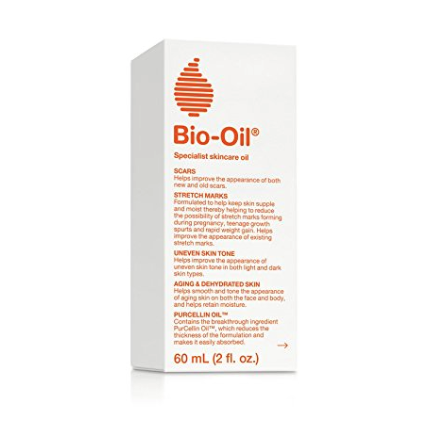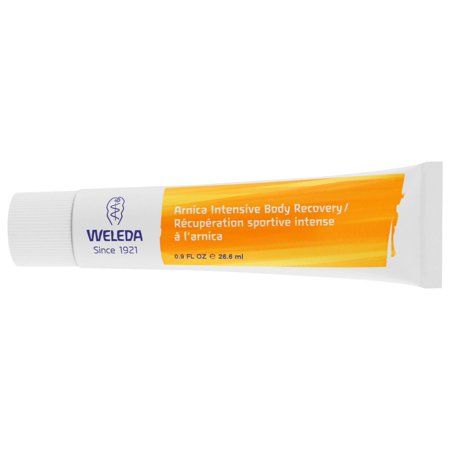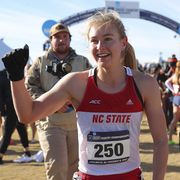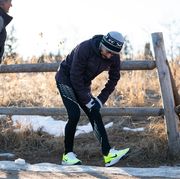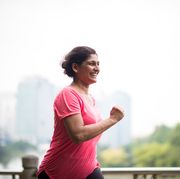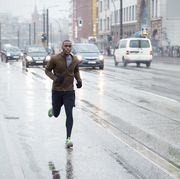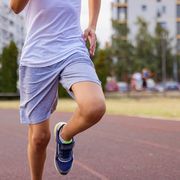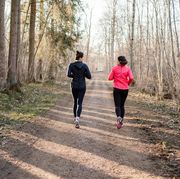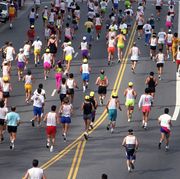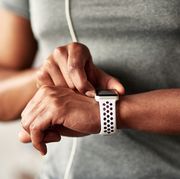One of the most useful stories you can share with new runners on Runner’s World is this list of definitive running terms, and for good reason—there’s a lot of jargon out there that’s hard for both newbies and dedicated runners to grasp and remember.
So whether you’re trying to remember exactly what a “negative split” means or want to win a debate over what the heck VO2 max is, this guide is here to help you out.
Achilles tendon: The tendon along the back of your foot that attaches your calf muscles to your heel bone. Achilles tendinitis can occur in new runners who increase their distance and/or intensity too quickly. This is especially true of new runners who have been inactive in recent years and who often wear heeled shoes (which can make the Achilles tendon shorter and tighter). Good flexibility in your calves and ankles can help to take some of the load off the Achilles tendon.
Aid station: Also called a water stop. Any point along a race course that offers water and sports drinks, handed out by volunteers. Often, at bigger races, people also hand out gels, energy bars, and other items.
Altitude training: Elite runners train at altitude to increase their number of red blood cells, improving oxygen delivery to their muscles. At altitude, the amount of oxygen in the blood is reduced because there’s less oxygen in the air. The kidneys then secrete more of a hormone called erythropoietin (EPO), which causes the body to create more red blood cells. Runners find they can train harder and perform better for several weeks after they return from about a month-long stay at altitude. If that’s not possible, arriving at altitude just 24 hours before the start is your best bet. You won’t acclimate, but you’ll limit your exposure to some of the negative effects of the thin air, such as dehydration and disturbed sleep. Start your race slower, and build intensity. Expect race times to be slower. Dehydration can occur at altitude because the air is thinner and dryer, so drink plenty of fluids. Get plenty of rest, and allow a few weeks back at lower altitudes before you race again.
Aquajogging: Running against the water’s resistance in the deep end, where you can’t touch the bottom, provides many of the benefits of running on land. A flotation belt will help keep you upright and give you stability.
Bandit: Someone who is participating in the race unofficially, without having registered or paid for an entry.
Bib: The sheets printed with numbers (called “bib numbers”) used to identify each runner in a race.
Black toenails: Lots of downhill running and too-small shoes can cause these, because both situations cause your toes to slam into the front of your shoe. They typically heal on their own within a few months.
Bloody nipples: These are often caused by chafing, friction caused by the rubbing of the nipples against the shirt while running. They’re more common in men and during cold weather, and they can be remedied by covering your nipples with adhesive bandages or nipple guards, which are sold in many specialty running stores.
Body Mass Index (BMI): A simple estimation of body fat that can be used to determine whether or not your weight is healthy. BMI is derived by comparing your height to your weight. It can be used by men and women of all ages. Use our BMI calculator to determine your BMI.
BQ: Shorthand for Boston Qualifying time. Often used to describe a marathon time that qualifies a person for entry into the Boston Marathon.
Brick workout: A workout that includes consecutive biking, then running. Often used by triathletes and duathletes to prepare for their goal events.
Cadence: The number of steps runners take per minute.
Carb-loading: The practice of increasing the percentage of carbs in your diet during the days leading up to an endurance event such as a marathon, half-marathon, or even a long training run. (Note: Carb-loading is not simply eating more of everything.) Carb-loading stores glycogen in the muscles and liver so that it can be used during the race; it is most effective when done along with a taper. Make sure your food choices are carbohydrate-rich, not full of fat. For example, choose spaghetti with red sauce instead of Alfredo sauce, or a bagel instead of a croissant.
Certified course: Most marathons and half-marathons are certified by USA Track & Field, which ensures that the distance of the race is accurately measured. For any running performance to be accepted as a record or for national ranking, it has to be run on a USATF-certified course.
Chafing: Bloodied, blistered skin caused by friction that happens after clothing-on-skin or skin-on-skin rubbing.
Chip: A small plastic piece attached to a runner’s shoelace that’s used to track a runner’s progress and record times during a race. Timing chips are activated once you step over the electronic mat at the start and finish of a race, and at various points in between. At most races, if you forget your timing chip, your race time will not be officially recorded.
Clydesdale: Races will often have divisions designated as “Clydesdale” for male runners who are over a certain weight. The minimum weight to qualify for that division varies from race to race.
Cool-down: A period of light physical activity, like walking, after a longer or harder run. Done to help bring the heart rate down gradually and prevent the blood from pooling in the legs.
Corral: A sectioned area at the lineup of a race that helps separate athletes into different pace groups. The faster an individual is, the more likely he or she will end up in one of the first few corrals. These corrals are especially important at large races, such as marathons, where elite athletes are running.
DNF: Did not finish, as in not completing a race.
DFL: Dead freakin’ last, as in the very last person to cross the finish line. (This isn’t a bad thing!)
Endorphins: Brain chemicals long credited with producing a “runner’s high,” the sense of elation that runners report experiencing. More recent research attributes this to endocannabinoids, molecules created by the body that are said to reduce pain and anxiety and promote well-being.
Fartlek: Speed play, or fartlek in Swedish (the concept originated in Sweden), is a speedwork format in which you run faster for however long (or short) you want.
Glycogen: The form of carbohydrates that is stored in your muscles and liver and is converted to glucose for energy during exercise. The amount of glycogen that is stored depends on your level of training and the amount of carbohydrates in your diet. The glycogen that is stored (so it can be made available for use during a race) is increased during periods of carb-loading.
GPS: Many running watches now have a GPS function that tracks your distance with a fairly high degree of accuracy. This can be helpful when you’re running new routes. But always remember that a GPS unit is a tool that might help your running, rather than something you have to answer to. There’s no inherent magic in standard measures of distance like a mile or kilometer. So don’t feel obligated to keep running until your GPS says you’ve exactly run a given distance. Most experienced runners learn to estimate their run lengths, and figure their mileage averages out to near accuracy over time.
Half Marathon: A race that’s 13.1 miles long. The half marathon has been the fastest growing race distance in the United States in the last few years. Many runners like the challenge of extending their endurance without having to do the training necessary to finish a marathon. You can find some of our most popular training plans for the distance below:
- First-Timers Half Marathon (10 weeks, 9–24 miles per week)
- Beginner Half Marathon (10 weeks, 13–23 miles per week)
- Beginner Half Marathon #2 (14 weeks, 17–26 miles per week)
- Intermediate Half Marathon (10 weeks, 21–29 miles per week)
- Intermediate Half Marathon #2 (14 weeks, 27–41 miles per week)
Hamstrings: The long muscles along the back of your legs. Strong, supple hamstrings are crucial for running your best, because they help to flex your knees and extend your hips. Weak or tight hamstrings shift some of the work of running to other body parts that aren’t as well equipped for the job. New runners whose daily lives involve a lot of sitting should include hamstring strengthening and flexibility exercises in their routine from the start.
Heart rate: How many times your heart beats in a minute. Training by heart rate accounts for many variables that affect how you feel from day to day. This makes it a better way to monitor how hard you’re working than an arbitrary measure such as your pace. The key is to know what your maximum heart rate is; once you know that, you can figure out the range of heart rates that correspond to the effort level you want for a given run.
Heat index: A combined measurement of temperature and humidity that shows how hot it feels outside. When humidity is high, it cripples the body’s ability to sweat—the body’s self-cooling mechanism—so the body retains more heat and it’s riskier to be outside. High humidity also increases the risk for conditions like heat cramps, heat exhaustion, and heatstroke. The National Weather Service issues an alert when the heat index is expected to exceed 105 to 110 degrees Fahrenheit for at least two consecutive days.
Hill repeats: A workout that includes sprinting uphill fast, jogging downhill at an easy pace to recover, and then repeating the sequence. It’s thought to be an efficient way to build leg strength, speed, and aerobic capacity. Hill repeats reduce your injury risk because it limits fast-running time and because the incline of a hill shortens the distance your feet have to fall, reducing the impact of each step.
Ice baths: Typically taken after long runs, races, and hard workouts, ice baths involve immersing one’s legs in ice water for 15 to 20 minutes. The ice constricts blood vessels and decreases metabolic activity, which reduces swelling and tissue breakdown. Once you get out of the cold water, the underlying tissues warm up, causing a return of faster bloodflow, which helps flush waste products out of the cells.
Iliotibial band: A thick, fibrous band that connects your hips and knees. It helps to flex and rotate your hips and stabilize and extend your knees. It can become easily strained, leading to iliotibial band syndrome, if you increase your mileage too quickly. The iliotibial band is also often irritated on the leg farther away from traffic if you regularly run on canted roads.
Interval training: Technically, this refers to the time you spend recovering between speed segments. But the term is commonly used to refer to track workouts in general or fast bouts of running.
Long slow distance runs (LSD): Any run that’s longer than a weekly run, which is the foundation of marathon and half-marathon training. These workouts help build endurance and psychological toughness that can help you get through race day.
Marathon: A race that’s 26.2 miles long. Although many runners are understandably proud of having run a marathon, some of the greatest runners in history have never done one, so don’t feel like you have to do a marathon to call yourself a runner. Most experts agree that you should have a year of regular running under your belt before you start training for your first marathon.
- First-Timers Marathon (16 weeks, 12–40 miles per week)
- Beginner Marathon (16 weeks, 16–44 miles per week)
- Intermediate Marathon (16 weeks, 26–51 miles per week)
- Advanced Marathon (16 weeks, 34–65 miles per week)
- 20-Week Marathon (20 weeks, 12–44 miles per week)
Minimalism: A movement in running shoes away from the highly cushioned, thickly heeled models that have become the norm over the last couple of decades. Minimalists say that lower, lighter models allow you to run with better, more natural form once you’ve adjusted to them. Many experienced runners find that running in a variety of shoes, including some minimalist models, is better than doing all of their running in the same shoes.
Negative splits: Running the second half of a race faster than the first half.
Orthotics: Devices worn inside running shoes to help treat or prevent injuries. Orthotics can be hard or soft, and of varying length, depending on what injury they’re trying to address. You should wear orthotics only if advised to by a sports medicine professional who says you need one to address a specific underlying imbalance or weakness.
Out-and-back: A course that entails running out to a turnaround spot, then running back to the starting point. Out-and-backs are a convenient way to get in runs in unfamiliar locales. They’re also a good option when you’re trying to run a little farther than you have before, because you don’t have the option of cutting the run short.
Overuse injury: Any injury incurred from doing too much mileage before the body is ready. Examples of common overuse injuries among runners include runner’s knee, IT-band syndrome, and plantar fasciitis.
Overpronation: Excessive inward roll of the foot, which can cause pain in the foot, shin, and knee.
Overtraining: A collapse in performance that occurs when the body gets pushed beyond its capacity to recover. It can lead to fatigue, stale training, poor race performance, irritability, and loss of enthusiasm for running. Serious overtraining can cause sleep disturbances, hampered immune function, poor appetite, and the cessation of menstrual periods in women.
Pace: How fast you’re running, usually expressed in terms of minutes per mile. Your running pace at a given effort level will vary greatly from day to day, depending on the weather, your fatigue level, and numerous other factors. While it’s good to have a general idea of how fast you’re running, it’s best not to base your running around hitting certain paces all the time. Doing so usually leads to working too hard, and can drain much of the enjoyment from your running. As you gain fitness, you’ll naturally speed up.
Personal record (PR): Term used to describe a runner’s farthest or fastest time in a race. Also called a Personal Best (PB).
Plantar fascia: Thick connective tissue that runs along the bottom of your foot from the heel bone to the base of your toe bones. It can easily inflamed by many of the same things that irritate the Achilles tendon, including too-rapid increases in distance and/or intensity, and poor flexibility of the calf muscles.
Quads/quadriceps: The four main muscles in the front of your legs. They help to stabilize your knees after your foot hits the ground when you’re running. New runners whose lives involve a lot of sitting often have quad muscles that are tighter and shorter than ideal for running. Good quad strength and flexibility helps to relieve strain on your knees.
Quality workouts: Any workouts that are faster or longer than daily runs. Within the context of marathon and half-marathon training, the term usually refers to workouts such as long runs, speed sessions, and tempo runs, which all require a day or two of recovery.
Recovery: Walking or easy jogging between faster-paced segments. Recovery lets your heart rate return to the point where you’re ready to run fast again, and it helps you regain the energy you’ll need for the next burst of speed.
Repeats: The fast segments of running that are repeated during a workout, with recovery in between. If you’re training for a marathon, you might run 1,000-meter repeats six times. For shorter races, like 5Ks, you might do shorter repeats of 400 meters or so at your goal race pace.
RICE: Refers to Rest, Ice, Compression, and Elevation. These measures can relieve pain, reduce swelling, and protect damaged tissues, all of which speed healing. They’re most effective when done immediately following an injury. RICE is the standard prescription for many aches and pains, such as strained hamstrings and twisted ankles.
Run/walk: Method popularized by Olympian Jeff Galloway. Walk breaks allow a runner to feel strong to the end and recover fast, while providing the same stamina and conditioning as a continuous run. By shifting back and forth between walking and running, you work a variety of different muscle groups, which helps fend off fatigue. To receive the maximum benefit, you must start the walk breaks before you feel any fatigue, during the first mile. If you wait until you feel the need for a walk break, then you’ve already let yourself get fatigued and defeated the purpose of the walk break.
Runner’s knee: A common running injury marked by inflammation of the underside of the kneecap. A common cause in new runners is building up mileage too quickly. Being at a good running weight and have strong, flexible quad and hip muscles help to lessen your risk for developing runner’s knee.
Side stitch: Also called a “side sticker,” this is a sharp pain usually felt just below the rib cage (though sometimes farther up the torso). It’s thought to be caused by a cramp in the diaphragm, gas in the intestines, or food in the stomach. Stitches normally come on during hard workouts or races. To get rid of a side stitch, notice which foot is striking the ground when you inhale and exhale, then switch the pattern. So if you were leading with your right foot, inhale when your left foot steps. If that doesn’t help, stop running and reach both arms above your head. Bend at your waist, leaning to the side opposite the stitch until the pain subsides.
Specificity: Training should be relevant and appropriate to the sport for which you’re training in order to maximize performance. Long runs, for instance, as opposed to cycling, are specific training for marathons and half-marathons because they prepare your muscles for the specific activity that you’ll be doing during the race: covering a long distance for hours at a time.
Speedwork: Also called intervals or repeats, speedwork refers to any workout run at a faster-than-normal pace. Often done at a track. Performed to increase cardiovascular fitness.
Splits: The time it takes to complete any defined distance. If you’re running 800 meters, or two laps, you might check your split after the first lap to shoot for an even pace.
Streaker: Typically refers to someone who has completed a race multiple years in a row. (Or somebody who runs every single day, like the #RWRunStreak!)
Stride rate: The number of times your feet hit the ground during a minute of running. This measurement is often used to assess running efficiency. Having a high stride rate—say 170 steps per minute or more—can reduce injuries and help you run faster. Typically the number used refers to the total number of times either foot hits the ground. So for a person with a stride rate of 170, the right foot and the left foot would each have hit the ground 85 times.
Strides: Also called striders or “pickups,” these are typically 80- to 100-meter surges that are incorporated into a warmup or a regular workout. Strides increase heart rate and leg turnover; they get your legs ready to run. Strides are run near 80 percent of maximum effort, with easy jogging in between.
Supination: The insufficient inward roll of the foot after landing. This places extra stress on the foot and can result iliotibial (IT) band syndrome, Achilles tendinitis, and plantar fasciitis. Runners with high arches and tight Achilles tendons tend to supinate.
Talk test: A way to see if you’re running at a comfortable effort level. During most of your runs, you should be able to carry on a conversation, which means you’ve passed the talk test. If you can’t say more than a few words at a time, you’re probably running too hard. Back off to where you can say a sentence at a time, and you’ll be able to run longer and better advance your fitness.
Technical clothing: This typically refers to clothing made of synthetic fibers that wick moisture away from the skin. These fibers do not absorb moisture, like cotton does, and they help prevent uncomfortable chafing.
Tempo: When runners talk about doing a “tempo run” they usually mean a sustained, faster-than-usual run of 3 to 6 miles at the pace they could sustain for an hour in a race. Tempo runs are said to feel “comfortably hard”—you have to concentrate to keep the effort going, but aren’t running with as much effort as a sprint or 5K race. Tempo runs are a good way to boost your fitness without doing hard track workouts.
Ten percent rule: Don’t increase mileage or intensity by more than 10 percent from one week to another. This is a classic injury-prevention rule meant to prevent a runner from doing too much, too soon, and getting injured.
Track: Most tracks are 400 meters long. Four laps, or 1600 meters, is approximately equivalent to 1 mile. Many runners use the term “track” to refer to a speed session done on a track.
Trail running: Doing some or all of a run off road. Trail running has become increasingly popular in part because running in the woods or mountains is usually more appealing than sharing the road with distracted drivers. Trails’ softer surfaces are also a nice change from asphalt. Expect to run slower than usual on trails.
USATF: USA Track & Field (usatf.org), the governing body of track and field, long-distance running, and racewalking in the United States. This nonprofit organization selects and leads Team USA to compete at the Olympics, the World Championships, and other international events each year. It also certifies racecourses for accuracy, validates records, and establishes and enforces rules and regulations of the sport.
Ultra/ultramarathon: Any race that’s longer than a marathon. The most popular ultra distances are 50K (31 miles), 50 miles, and 100K (62 miles). A lot of ultras are run on trails or in other natural settings, and almost all ultras have much smaller fields than the average half marathon or marathon.
VO2 max: A measurement of the maximum amount of oxygen that a person can consume per minute while exercising. VO2 max is determined by genetics, gender, body composition, age, and training. Runners with a naturally high VO2 max often find it easier to run faster because their hearts can deliver more oxygen to their muscles. There are many ways to boost VO2 max, including speedwork, which forces the heart to pump blood at a higher rate.
Warm-up: A period of walking or easy running or any light activity that is done for 10 to 20 minutes before a workout. It gradually increases heart rate, breathing rate, and bloodflow to the muscles, and it prepares the body for more vigorous work. A good warmup allows the body to work more efficiently and helps prevent muscle pulls and strains.
The Wall: Typically refers to a point when a runner’s energy levels plummet, breathing becomes labored, and negative thoughts begin to flood in; this often happens at mile 20 of a marathon. Experts say that it usually happens two-thirds of the way through any race, no matter the distance. Hitting the wall often occurs because you’ve run out of fuel and need carbohydrates (like a sports drink or an energy gel) that the body can convert into fuel for the muscles to use.
Wind chill: How cold it really feels when you’re outside. As the wind grows stronger, it makes it feel much colder than the air temperature.

Scott is a veteran running, fitness, and health journalist who has held senior editorial positions at Runner’s World and Running Times. Much of his writing translates sport science research and elite best practices into practical guidance for everyday athletes. He is the author or coauthor of several running books, including Running Is My Therapy, Advanced Marathoning, and Meb for Mortals. Scott has also written about running for Slate, The Atlantic, the Washington Post, and other members of the sedentary media. His lifetime running odometer is past 110,000 miles, but he’s as much in love as ever.



